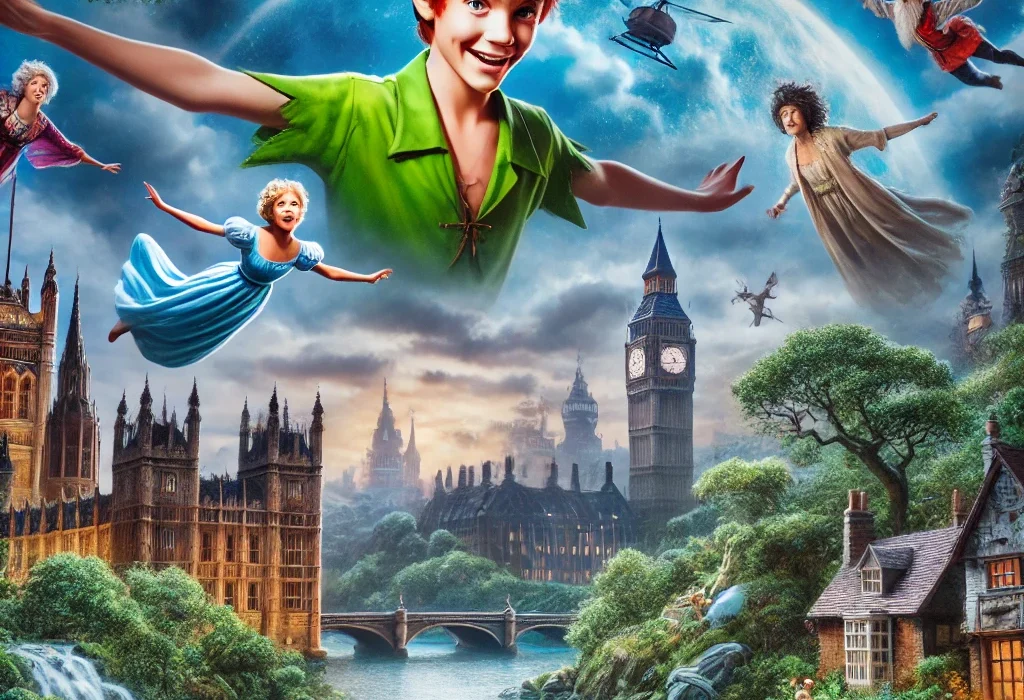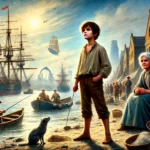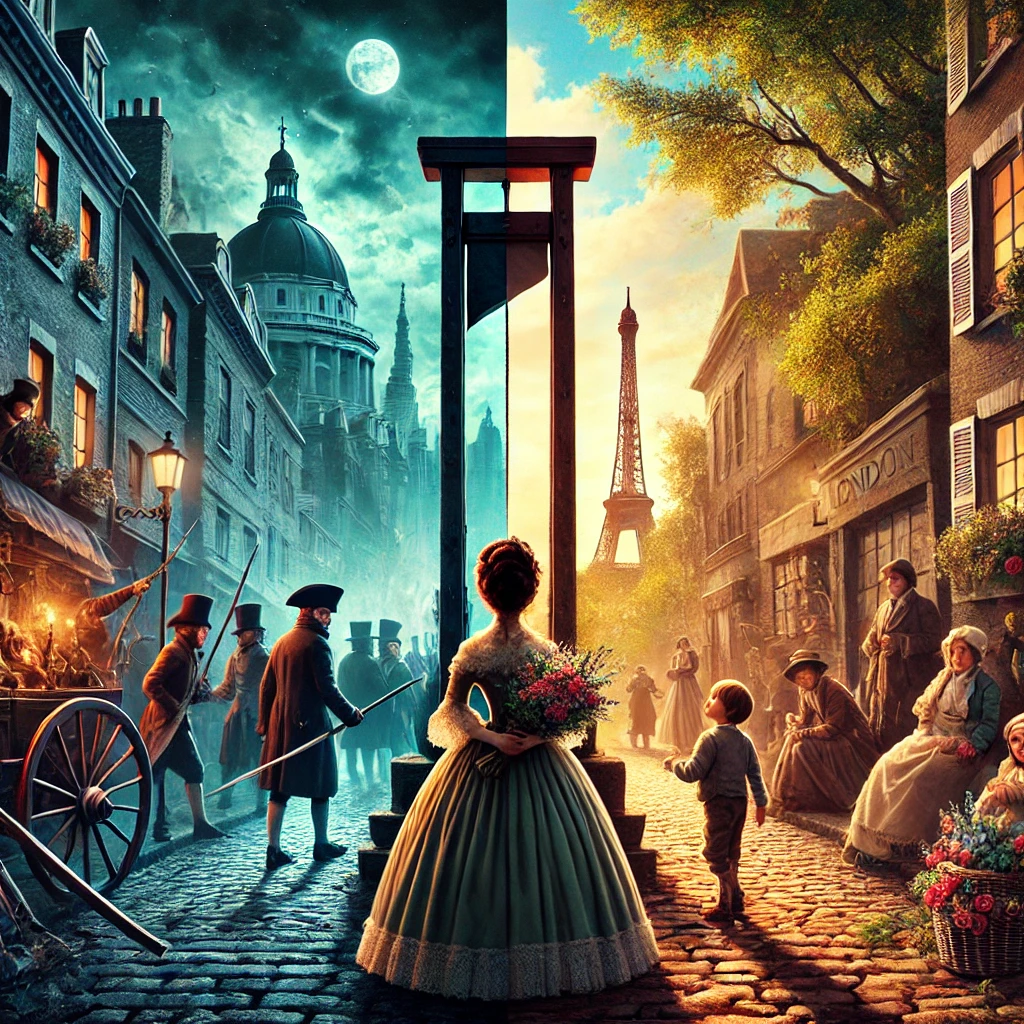“Peter Pan” (also known as Peter and Wendy) is a timeless novel by Scottish author J.M. Barrie, first published in 1911. The story follows the adventures of Peter Pan, the boy who never grows up, as he takes three children—Wendy, John, and Michael Darling—from London to the fantastical world of Neverland. There, they encounter fairies, pirates, mermaids, and the lost boys. Through imaginative adventures, Barrie weaves themes of youth, freedom, and the bittersweet nature of growing up.
Plot Summary
Wendy Darling was a young girl on the cusp of growing up, living in a cozy nursery with her two brothers, John and Michael. Every night, as they drifted into dreams, their mother, Mrs. Darling, would tidy their minds, putting away their childish thoughts for the next day. But lately, something unusual had been happening: the children were dreaming of a boy named Peter Pan, whose name seemed scrawled across their minds. One night, while Mrs. Darling was dozing by the fire, Peter Pan himself flew into the nursery, accompanied by a tiny, glowing fairy named Tinker Bell. Peter had come to retrieve his shadow, which had been left behind during a previous visit.
Awakened by Peter’s crying, Wendy gently sewed his shadow back onto him. In return, Peter invited her—and her brothers—to fly with him to Neverland, the magical island where he lived, a place filled with mermaids, fairies, pirates, and adventures beyond their wildest dreams. With a sprinkle of fairy dust and happy thoughts, the children soared out of their nursery window, following Peter through the starry night to Neverland.
Neverland was not merely a fantasy but a living, breathing place, shaped by the imagination of children. The island teemed with wonders: colorful lagoons, enchanted forests, and secret hideouts. But it also held dangers. The infamous pirate, Captain Hook, ruled the seas, ever on the hunt for Peter Pan, the boy who had cut off his hand and fed it to a hungry crocodile. Now, Hook lived in constant fear of the ticking reptile, which followed him, waiting for the chance to finish the job.
Upon arriving in Neverland, Wendy, John, and Michael found themselves caught in a whirlwind of excitement. Peter introduced them to his band of lost boys—children who had fallen out of their prams and been forgotten by their parents. Without a mother to care for them, they looked to Wendy for comfort, and she eagerly took on the role, telling them stories and tucking them in at night. But as much as Neverland was a playground of delight, it was also a battleground. The boys were constantly on guard against Captain Hook and his crew, as well as the Native tribes who lived on the island. Yet, Peter, with his cocky smile and fearless attitude, always seemed to be one step ahead of danger.
In the depths of Neverland’s jungle, Captain Hook plotted his revenge. He was a man consumed by his hatred for Peter, tormented by the memory of their last duel. Hook’s obsession with defeating Peter was matched only by his fear of the crocodile that stalked him relentlessly, ticking away the seconds of his life. But despite his evil schemes, Hook could never outwit Peter’s quick thinking and boundless energy.
While Peter and the lost boys thrived on the island’s dangers, Wendy began to feel the weight of responsibility. She cared deeply for the lost boys, but she missed the safety and comfort of her home in London. Peter, who never thought about the future or consequences, could not understand Wendy’s growing desire to return. To him, time was meaningless. He would forever be the boy who wouldn’t grow up.
One night, Hook devised his most sinister plan yet. He captured Tinker Bell, knowing that the jealous fairy harbored resentment towards Wendy for her closeness to Peter. Using this to his advantage, Hook tricked Tink into revealing the location of Peter’s secret hideout. Armed with this knowledge, the pirates launched a surprise attack. Wendy, John, Michael, and the lost boys were captured and taken aboard Hook’s ship, the Jolly Roger. Hook left behind a deadly gift for Peter—a bomb, disguised as a present, meant to blow him to pieces while he slept.
But Tinker Bell, though still jealous, could not let Peter perish. Racing against time, she snatched the bomb just as it was about to explode. The blast nearly ended her life, but her devotion saved Peter, who rushed to her side. With a fierce determination, Peter flew to Hook’s ship to rescue his friends.
A fierce battle erupted between Peter and the pirates. The lost boys and the Darling children fought bravely, but it was Peter who faced Hook in a final, climactic duel. On the deck of the Jolly Roger, the two enemies clashed, Hook’s blade meeting Peter’s dagger. The air was thick with tension, as Hook’s every movement was followed by the ticking of the crocodile. In the end, Peter’s agility and youthful spirit triumphed. Hook, overbalanced and defeated, fell into the jaws of the waiting crocodile, finally meeting his doom.
With Hook gone, the pirates scattered, and the children were free. But as the excitement faded, Wendy realized it was time to return home. The lost boys, seeing in her the mother they had always longed for, wished to come with her. Peter, however, refused. He could never leave Neverland, never grow up, and never embrace the life of responsibility that awaited Wendy. He promised to visit her, but even as he made the vow, Wendy knew Peter would soon forget.
Peter flew Wendy, John, and Michael back to their nursery window. When they arrived, they found their parents waiting, hearts full of love and worry. The lost boys, too, found a new home with the Darlings, welcomed as part of the family. But Peter, unable to stay in a world of adults, slipped away silently, back to Neverland, where the sun always shines, the adventures never end, and the boy who wouldn’t grow up could remain forever young.
In the years that followed, Wendy grew older, as children must. She often thought of Peter, wondering if he still visited the nursery window, searching for her. And though she grew up, married, and had children of her own, she never forgot the boy who had taken her hand and taught her to fly.
Main Characters
Peter Pan: The mischievous and carefree boy who can fly and refuses to grow up. Peter is the hero of Neverland and leader of the lost boys. His personality is defined by his eternal youth, arrogance, and adventurous spirit. He represents the essence of childhood wonder, yet he is also emotionally detached and forgetful, even toward those who care about him.
Wendy Darling: A nurturing and imaginative young girl who is swept away to Neverland by Peter. She becomes a mother figure to the lost boys and Peter, embracing the idea of caring for others. Wendy grapples with the pull between the desire for adventure and the inevitable call of responsibility and growing up.
Captain Hook: The main antagonist, a villainous pirate captain obsessed with defeating Peter Pan. Hook is both cruel and cultured, with a particular hatred for Peter after losing his hand to him in a fight. His constant fear of the ticking crocodile, which swallowed his hand and now hunts him, adds a layer of dread to his character.
Tinker Bell: Peter Pan’s fiercely loyal but temperamental fairy companion. Tinker Bell is jealous of Wendy’s closeness to Peter, and although small, her jealousy leads her to occasionally act out in harmful ways. Despite this, she ultimately proves her loyalty to Peter.
John and Michael Darling: Wendy’s younger brothers who join Peter Pan and Wendy on the adventure to Neverland. John is more logical and eager to prove himself, while Michael is the youngest and more innocent, experiencing the magical world of Neverland through a child’s wonder.
Theme
The Fear of Growing Up: At the heart of Peter Pan is the theme of resisting the passage of time and the inevitable process of growing up. Peter Pan embodies the fantasy of eternal youth, while Wendy represents the gradual acceptance of adulthood and responsibility. The story reflects the tension between the desire to stay in a carefree state of childhood and the inescapable reality of maturation.
Innocence and Adventure: The world of Neverland represents the imagination and boundless freedom of children. The adventures with pirates, fairies, and mermaids symbolize the excitement and purity of childhood exploration, but also reveal the perils and fleeting nature of such innocence.
Parenthood and Family: Throughout the novel, Wendy takes on the role of mother to the lost boys, and her relationship with them mirrors traditional family dynamics. Themes of caregiving, protection, and the nurturing aspect of motherhood are contrasted with the lost boys’ longing for maternal love and stability.
Mortality and Time: Despite its whimsical tone, Peter Pan has a poignant undercurrent about the passage of time and death. Captain Hook’s fear of the ticking crocodile represents the inevitable approach of death. Meanwhile, Peter’s refusal to grow up and forgetfulness of those he loves hints at the loss that comes with eternal youth—the loss of memory and emotional connection.
Writing Style and Tone
J.M. Barrie’s writing style in Peter Pan is whimsical, humorous, and occasionally melancholic, combining a childlike sense of wonder with moments of introspective depth. His use of descriptive, imaginative language brings the magical world of Neverland to life, while his playful narrative voice often breaks the fourth wall, directly addressing the reader in a conversational tone. This creates a sense of intimacy and inclusivity, as though the reader is part of the story.
Barrie’s tone is often lighthearted, filled with wit and irony, yet there are darker undercurrents that reveal the story’s complexities. The innocence of Peter Pan is frequently juxtaposed with the harshness of time and mortality, creating an emotional depth that resonates with both children and adults. His portrayal of characters like Peter, who is charming yet detached, and Hook, who is menacing yet pitiable, reflects the nuanced and sometimes contradictory nature of human desires and fears.
We hope this summary has sparked your interest and would appreciate you following Celsius 233 on social media:
There’s a treasure trove of other fascinating book summaries waiting for you. Check out our collection of stories that inspire, thrill, and provoke thought, just like this one by checking out the Book Shelf or the Library
Remember, while our summaries capture the essence, they can never replace the full experience of reading the book. If this summary intrigued you, consider diving into the complete story – buy the book and immerse yourself in the author’s original work.
If you want to request a book summary, click here.
When Saurabh is not working/watching football/reading books/traveling, you can reach him via Twitter/X, LinkedIn, or Threads
Restart reading!








